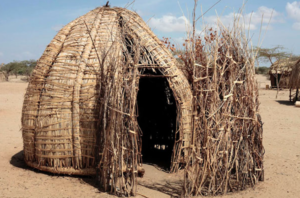Published by Stony Brook University’s School of Journalism February 03, 2013
By Rebecca Anzel
Reporter
In the midday desert sun, as loose silt and sand are carried in the occasional breeze, the only breaks along the bleak horizon are stunted trees and straw-colored huts. Although the huts’ appearance is simple, the construction is more complex than it might seem.
Women harvest fronds from the doum palm at just the right time. They don’t want the fronds to break or tear as they weave them tightly to form a structure’s roof and siding.
The women map the structure’s shape and location on the ground before they begin any construction. Then they dig the foundation to mimic the shape of the hut they will build on top of it.
Each structure’s purpose is considered carefully. Some huts have a complete, conical roof. Women and children rest inside during the brutal heat of the day. Once weaned, children sleep in these huts with other children about the same age. There is no furniture beyond a few rolled-up sleeping mats, also woven by the women. Utensils and vessels hang from the walls or are tucked among the fronds.
Other huts are open to the sky, surrounded by a wall of upright branches interwoven with palm fronds. Men sleep in these huts, under the bright stars, except on the all-too-rare rainy nights.
Assuming building materials are readily available, building a hut can take as little as a week. When built soundly, each structure can last for about 10 years.
- The building material and square shape of this hut in Loreng’elup makes it untraditional. The mud is made from a clay and water mixture that adds more stability to the structure than the more traditional reed buildings. (Rebecca Anzel)
- The building material and square shape of this hut in Loreng’elup makes it untraditional. The mud is made from a clay and water mixture that adds more stability to the structure than the more traditional reed buildings. (Rebecca Anzel)
- The building material and square shape of this hut in Loreng’elup makes it untraditional. The mud is made from a clay and water mixture that adds more stability to the structure than the more traditional reed buildings. (Rebecca Anzel)
- The building material and square shape of this hut in Loreng’elup makes it untraditional, Turkana, Kenya, Jan. 15, 2013. The mud is made from a clay and water mixture that adds more stability to the structure than the more traditional reed buildings. (Rebecca Anzel)
- The building material and square shape of this hut in Loreng’elup makes it untraditional. The mud is made from a clay and water mixture that adds more stability to the structure than the more traditional reed buildings. (Rebecca Anzel)
The Journalism Without Walls program originally published this piece online here.






